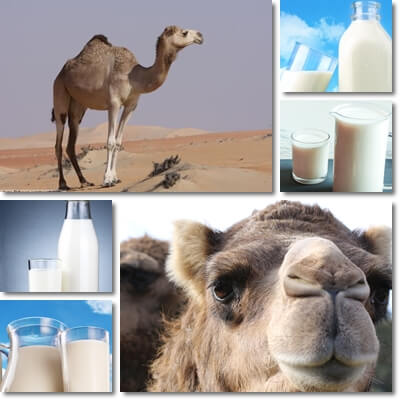Camel milk is quite the novelty food in western diets, but one that is quickly gaining status as a functional food due to its apparently superior nutritional value compared to the readily consumed cow’s milk. Most of the benefits of camel milk stem from its higher content of certain vitamins and minerals, notably vitamin C, vitamin B12, iron, magnesium and potassium, as well as lower fat content compared to the default – cow’s milk (between 3.2 and 3.4 g of fat per 100 ml, whereas whole cow’s milk has 3.25 to 3.7 g of fat for the same amount).
Among its most appreciated properties is a lower lactose content, between 3.22 and 3.65 g of the sugar lactose per 100 ml. By comparison, whole cow’s milk has between 4.6 and 5.4 g of lactose per 100 ml, making camel a better choice for those with milder forms of lactose intolerance. Lastly, camel’s milk is missing two major proteins: beta-lactoglobulin and a beta-casein. And this is a good thing seen that both of these proteins hold allergenic potential and are two of the biggest factors involved in allergic reactions to cow’s milk. As a result, the novelty dairy product is being considered as a substitute for people with milk allergies.

What does camel milk look and taste like?
The milk is fluid with an opaque, whitish color. If solids are high (11-12%), it may take on a more viscous consistency (primarily as a result of changes in diet/seasonal changes that impact food availability). Taste is faintly sweet, with a slight saltiness and, occasionally, sharp flavor notes. The fresh milk has a weak acidity, with a pH that is close to neutral (7). Actually, reports show camel milk pH is 6.63-6.64 to 6.57-6.97.
Camel milk nutrition facts per 100 ml/100 g
Fat content in camel milk:
Camel milk has an average content of 3.2 – 3.4 g of fat, although fat content can go as low as 1.8 g and as high as 5 g. Milk obtained during hot summer periods had a higher water content and a lower solids content, notably fat and protein. Fat profile stands out for its high unsaturated fatty acids content, especially good Omega-6 (linoleic acid) values.
Protein content in camel milk:
Camel milk has an average content of 2.9 – 3.2 g of protein, although exact content varies between 1.8 g and 3.5 g of protein. Camel milk also naturally has both whey proteins and casein proteins.
Carbohydrate content in camel milk:
Form: lactose. Camel milk has an average of 3.2 to 3.6 g of lactose per 100 ml, but exact content varies between 2.4 g and up to 4.3/5.3 g of lactose per 100 ml.
Vitamins and minerals in camel milk
- Vitamin A: 45 mcg (micrograms)
- Vitamin B12: 123 mcg
- Vitamin C: 98 mg to 117 mg (milligrams) – only in raw milk (unpasteurized, unfermented)
- Calcium: 131 mg
- Iron: 0.76 mg
- Magnesium: 74 mg
- Potassium: unspecified, except that it’s known that camel milk has a higher content of potassium than cow’s milk
- Sodium: 67 mg
- Other vitamins and minerals in camel milk: vitamins B2, E and D, copper, phosphorus and zinc (exact amounts are unspecified, but noted as good, with a superior content comparable to cow’s milk).
It’s important to understand there is great variability in the nutritional profile of camel’s milk. The species of camel, geographical origin of the milk, age and state of health of the animal, diet, seasonal changes that impact food availability, hormonal changes, milk output as well as other factors affect the nutritional quality of the milk resulting in milk with different nutritional values. And that is normal.
Naturally, cow’s milk has a varying nutritional profile too. But considering that it’s the number one dairy milk consumed worldwide, industry standards have been developed to render cow’s milk from commercial production equally nutritious.

What are the benefits of camel milk?
Immune system-boosting properties
Camel milk has scientifically proven antibacterial, antiviral and antifungal properties derived from immunoglobulins and lactoferrin (proteins), and the enzyme lactoperoxidase, all occurring naturally in the milk. And considering the fact that camel milk does not undergo industrial processing like cow’s milk, it gets to keep its beneficial properties.
Anti-tumor properties
Camel milk has been shown to possess anti-tumor properties derived from the enzyme lactoperioxidase.
Lower allergenic potential
Camel milk has no beta-lactoglobulin and beta-casein, the two proteins that most commonly cause milk allergy. This particular type of dairy milk is considered a good substitute for cow’s milk in children with milk allergy. However, a lower allergenic potential does not equal no allergenicity.
Provides nourishment for the brain
Camel milk is a good source of food for the brain. The protein, fats as well as B vitamins occurring naturally in the milk support normal brain development in children, and boost the development of cognitive abilities such as thinking, learning and memory. Camel milk is also good during pregnancy because it helps with the correct development of the brain and nervous system of the baby.
The benefits of camel milk for the brain and nervous system health stem primarily from a high unsaturated fatty acids content, but also a varied fatty acids profile that includes unsaturated, saturated fats and cholesterol which physically contribute to brain and nervous system cells makeup.
Lower lactose content
Camel milk is usually naturally lower in lactose than cow’s milk and thus considered a better option for those with mild lactose intolerance who would benefit from a reduced intake of lactose, but also from regular consumption of milk.
Low glycemic food
Camel milk is classified as a very low glycemic index food on the glycemic index scale. While it is a source of sugar, the content of sugar is low and balanced by the content of fat and protein which prevents spikes in blood sugar levels. The low sugar, but good protein and fat content contribute to more stable blood sugar levels in diabetics which is good for diabetes management.
Source of insulin
Studies report camel’s milk contains significant amounts of the hormone insulin and is believed to help with blood sugar control in diabetes. Some sources cite insulin-like proteins to be responsible for benefits in diabetics.
Benefits for viral diarrhea
Camel milk can help with recovery from diarrhea caused by viral infections. Benefits include a faster recovery time and restorative effects owed to the good nutritional profile of the milk and its hydrating properties and prebiotic effects. The benefits of camel milk for diarrhea caused by viral infection are owed primarily to immuno-modulating proteins (for example: immunoglobulins, lactoferrin) and enzymes (for example: lysozyme, lactoperoxidase).
Combats dehydration
Camel milk is 88% to 91% water and hydrates the body, helping combat dehydration and its side effects such as headaches, lethargy, low energy and low mood, fatigue and cardiovascular side effects. Furthermore, the milk variety is a source of dietary minerals and B vitamins with tonic properties.
Nutritious food
Camel milk can be classified as a nutritious food: it provides fats, protein, sugar and most essential vitamins and minerals. It is a wholesome, nutritious food with energizing and restorative properties. In addition to providing nourishment, camel milk is also satiating and a source of both quick and lasting energy.
Prebiotic and probiotic food
Unprocessed fresh and fermented camel milk is a prebiotic and probiotic food with benefits for digestive microflora and gut health. The fresh and fermented milk both feeds existing gut bacteria, and enriches existing populations, actively contributing to creating a balanced and health gut environment for good digestive health.
Natural remedy for stomach ulcers
Camel milk is a type of milk with low acidity and has a restorative action on gastrointestinal mucosa, helping combat symptoms of a stomach ulcer and encourage healing of the affected gastric mucosa.
Good for stomach ache and acid reflux
Drinking fresh camel milk helps calm stomach aches and digestive upset caused by excessive stomach acidity in acid reflux disease. If your stomach hurts or you are experiencing severe heartburn and chest pain or chest burning, regurgitation of stomach juices, a bad taste in the mouth caused by the backflow of stomach juices, then having a glass of chilled sweet camel milk can help calm discomfort and provide relief.
Other benefits and potential uses
Camel milk is being investigated for its therapeutic potential in Crohn’s disease and food allergies treatment.
Where can you get camel milk in the US?
You can buy camel milk in the USA from camel dairy farms. Although few, these exist and supply the milk to consumers, either directly or via retailers. It may be a good idea to first take a look at the dairy or health food section in your local supermarket or check out health food stores in your area. You can always talk to a manager or write to your local supermarket and ask if they could bring in food products by customer request. If they do, it may be a good idea to inquire about a time-frame as well, if they can provide you with one. Lastly, contact a few camel dairy farms and see if they supply the milk directly to consumers.
It’s important to know that this particular product cannot be outsourced and must be obtained from camel farms within the US. Chances are, there won’t be a camel dairy farm near you, but a quick search online will tell you which is the closest while a call or e-mail can tell you how you can get the milk from them. It’s also not very likely you’ll get fresh camel milk in the US since legislation is for pasteurized milk. And that’s okay since it means better food safety for you, the consumer. Outside of the US, you can find raw and fermented options. Large populations of domesticated camels exist throughout the Middle East, Central Asia and various parts of Africa.
The pasteurized milk is just as good from many points of view. However, know that pasteurization destroys most of the vitamin C as well as affects B vitamins too. But producers may fortify the milk with missing vitamins to bring it back to its original nutritional value and sometimes other nutrients too. Another major difference is that pasteurization means a loss of the natural probiotic properties of the product, which is a disadvantage of course, but one that is balanced out by better food safety.
